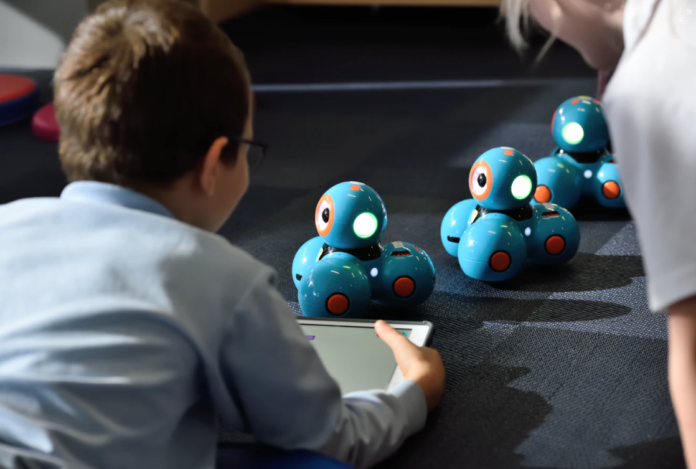Classrooms are dynamically impacted by the dual forces of technological evolution and student expectation. This is especially critical in K–12 environments as millennials age out of the school system and are replaced by Generation Z.
McKinsey & Company notes that Gen Z is composed of digital natives who prioritize unique identity and are rooted in the “search for the truth.”
Student engagement is changing, driven by digital natives looking to combine organic social interaction with science, technology, engineering and math discovery. Cracking the K–12 connection code requires a new approach, one that combines active-learning pedagogy with robotics in the classroom to deliver an interactive, immersive learning experience.
New Learning Styles Offer Different Types of Learning
Stand-and-deliver discourse won’t do it for Gen Z students. Access to social technologies combined with an increasing recognition of the need for unstructured play and flexible learning environments has prompted pedagogical shifts that help students engage, rather than simply observe.
Here are a few emerging approaches:
- Project-Based Learning: PBL focuses on giving students real-world challenges that help them develop problem-solving skills. After a basic introduction to concepts or events, students work in groups to engage with what they’ve learned. Tech integration — from laptops and mobile apps to robots — aligns with students’ everyday experience and helps them connect with critical concepts.
- 360-Degree Learning: As noted by Building Design and Construction, schools are now “emphasizing practical, hands-on experience and personalized learning” by creating new learning environments that include outdoor classrooms, gardens and natural play spaces. Here, the goal is to combine kids’ need for active play with the development of social and STEM skills by adopting a comprehensive learning approach.
Robotics and Digital Tools Engage Students on a New Level
Pedagogy forms one pillar of student engagement, but zeroing in on Gen Z learning also means leaning into emerging technological trends, including:
- Artificial Intelligence: New AI solutions can help teachers automate key classroom processes, integrate advanced technologies, acclimate students to technological change, discover key learning trends and help identify personalized learning potential.
- Gamification: According to MDR Education, gamification is now a top K–12 tech trend. Here, the focus is on integrating game mechanics — which mirror Gen Z’s day-to-day experience of on-demand mobile applications — to “introduce an element of fun into lessons, leading to more participatory, and ultimately, more memorable classroom experiences.”
The STEM Robot Revolution Hits K–12
What does this mean for robotics in the classroom? In practice, robots help bridge pedagogy and technology, offering physical manifestations of key educational concepts.
As noted by Built In, robots like Robin — an almost 2-foot-tall, friendly looking humanoid — are helping toddlers learn new languages by playing simple colour identification and movement games. Here, social interaction and STEM education go hand in hand; kids experience robots at a personal, physical level and unwittingly expand their knowledge base.
Other developers are leaning into the natural tendency for kids to connect with humanlike robots — according to Cynthia Breazeal, associate director for the Bridge: MIT Quest for Intelligence, children have a “special kind of affinity” with these devices. Fuzzy, childlike and interactive robots such as Tega prompt social responses in children, who treat these bots like living beings rather than machines.
Robots such as Sphero and Ozobot, meanwhile, empower kids to learn critical coding skills without the need for desktop computer setups or tedious memorization. Sphero can be programmed using one of three onboard languages — macros, OrbBasic or Oval — to roll, display colours and track its position.
Ozobots empower kids to discover basic coding commands simply by drawing on paper. Different colours will produce different behaviours, allowing students to observe outcomes in real time.
K–12 Robotics Programs Embrace Drones
Robots are also broadening the scope of student observation and discovery. As drones become popular out-of-school tech pastimes, and inform potentially ambitious package delivery plans, some schools are leveraging this technology to get STEM learning off the ground.
As noted by EDU4ME, drones can help social studies students recognize the real-world impact of geography and cartography on history and current events. They’re also being used to help students better understand coordinate mapping and distance calculations.
In addition, drones offer a bridge to more advanced design understanding and post-school career options, helping students understand key concepts around aerodynamics, weight and balance.
Are Robots Going to Replace Teachers?
Robotic teaching offers the possibility of improved outcomes and reduced red tape, but there’s an understandable concern: Could robots replace human educators? A 2017 WeForum piece offers up this dystopian future as a distinct possibility, with British education expert Anthony Seldon suggesting substantive robotic replacement by 2027.
Of note, STEM robots won’t be the cause of this educator edge-out; friendly classroom bots and drone design challenges aren’t the stuff of staffing nightmares. As noted by PBS, it’s the rise of socially intelligent robots — those capable of responding to social and emotional cues using AI — that could potentially pose a challenge.
Realistically, however, large-scale replacement is unlikely. According to a recent study from the University of Plymouth, while robotics in the classroom may become part of the “educational infrastructure,” their key role will be to “free up precious time for teachers, allowing the teacher to focus on what people still do best — provide a comprehensive, empathic, and rewarding educational experience.”
Students, STEM and the New System
Robots have arrived in education, offering K–12 teachers a way to engage Generation Z and deliver comprehensive and compelling classroom experiences.
From STEM teaching tools to the rise of drone learning, the new school system favors robotic functions, but will always rely on educators to link emerging technologies with teachable moments.
To learn more about CDW’s solutions for K-12 education, visit CDW.ca/education







